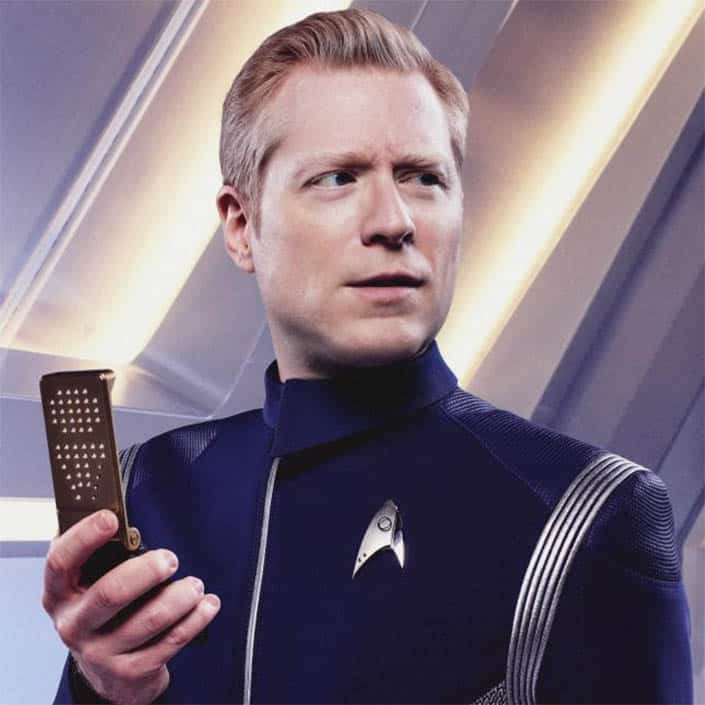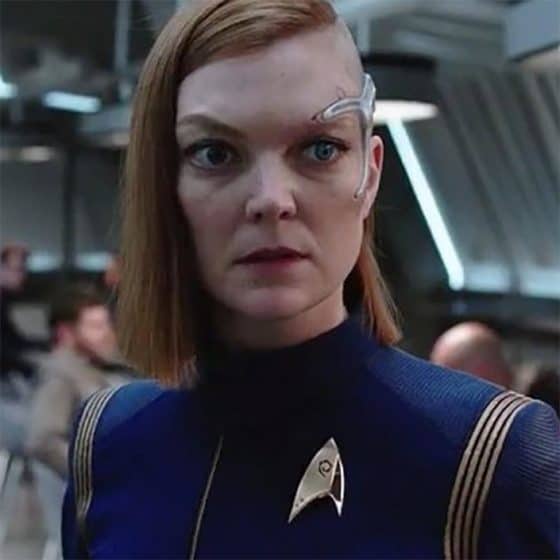
Introduction
Anthony Rapp’s Paul Stamets arrived on Star Trek: Discovery with two headline‑making markers: the series’ first openly gay regular‑character couple through Stamets’ relationship with Dr. Hugh Culber, and a central scientific function as the navigator of Discovery’s experimental spore drive. Those points are well documented in franchise histories and character summaries (see the character’s overview on Wikipedia) and have been celebrated across the fan community. What often gets less attention are the details behind how Rapp built the role, how canon crossed into gaming with his voice and likeness, and how official Trek platforms have used him as an interpreter of Discovery’s most complex story mechanics. Following the trails laid down in primary sources—including interviews on Space.com, StarTrek.com, and a Paramount+ feature—reveals a fuller portrait of an actor whose craft and advocacy shaped one of modern Trek’s most distinctive characters.
Casting origins, and what’s actually verifiable
Discovery’s early announcements moved quickly in late 2016, and Rapp’s casting as Stamets became public in November of that year amid a wider wave of casting news as the series ramped up production for its streaming debut. The character’s page on Wikipedia notes that timing and situates Stamets as Discovery’s astromycologist and spore drive specialist within the show’s ensemble (https://en.wikipedia.org/wiki/Paul_Stamets_(Star_Trek)?utm_source=openai). That publicly verifiable record establishes when the role entered the Trek conversation and how producers positioned Stamets in Discovery’s science‑forward premise.
What remains harder to confirm from the cited sources are any behind‑the‑scenes narratives about casting changes or reshuffles that sometimes circulate in fan discourse. The linked materials do not provide an on‑record producer account detailing such a switch. Framing that absence accurately matters: without a primary statement from a producer in these sources, the idea of a casting shuffle should be treated as a research gap rather than a claim. For readers assembling a production chronology, the verifiable point is the public November 2016 reveal and the role description that accompanied it on official and encyclopedic platforms.
Meeting the real Paul Stamets
One of the most distinctive aspects of Discovery’s approach to science storytelling was giving a character the name and expertise of a real, contemporary mycologist. In a Space.com interview conducted around his Star Trek Online work, Rapp described meeting the real Paul Stamets and talked about the exchange of perspective that followed (https://www.space.com/star-trek-online-awakening-anthony-rapp-interview.html?utm_source=openai). Paraphrasing his account, the conversation broadened his curiosity about mycology and affirmed the value of rooting sci‑fi ideas in rigorous scientific inquiry. He spoke about appreciating the real Stamets’ trailblazing research and said that learning directly from him helped inform how the character expresses passion for the fungal networks Discovery dramatizes through the spore drive.
In canon, Stamets stands at the junction of speculative propulsion and practical lab work, the scientist‑engineer whose expertise makes Discovery’s instantaneous “jump” capability possible (https://en.wikipedia.org/wiki/Paul_Stamets_(Star_Trek)?utm_source=openai). That setup let the series portray a science process—not only in expository briefings but in the lab’s rhythms and in Stamets’ evolving understanding of the mycelial network’s ecological complexity. Rapp’s description of meeting the real researcher underlines a design choice that Trek has long pursued: intertwining fiction with real‑world fields to spark curiosity. Without overstating what a single meeting can accomplish, it’s clear from his Space.com remarks that he brought that encounter back to the set as a touchstone for how Stamets speaks, thinks, and challenges assumptions.
That bridge between science interest and representational ethos also tracks with Discovery’s broader goals. Conversations about inclusion in Trek often focus on characters and relationships, rightly so—but Discovery also insisted that its scientists be three‑dimensional, emotionally literate people. Rapp’s articulation of scientific curiosity as part of the character’s identity complements how the show frames Stamets’ relationship with Culber: both are integral to who he is, and neither overshadows the other.
Voice, likeness, and cross‑platform work
For fans who follow Trek across media, 2019 delivered a noteworthy crossover: Rapp reprised Stamets in Star Trek Online, lending both his voice and likeness to the MMO’s Awakening story arc. The official StarTrek.com announcement confirmed his involvement and outlined how the narrative would intersect with Discovery‑era lore (https://www.startrek.com/news/star-trek-online-anthony-rapp-idw-collaboration?utm_source=openai). Space.com’s interview with Rapp likewise centers on that expansion, with him discussing the collaboration and what it meant to revisit the character in a different format (https://www.space.com/star-trek-online-awakening-anthony-rapp-interview.html?utm_source=openai).
This kind of cross‑platform appearance is meaningful for several reasons:
- It extends Discovery’s storytelling texture into a long‑running game that has often served as a connective tissue between series eras.
- It preserves performance consistency by bringing the originating actor’s voice and face into a game world, reinforcing character continuity for players who also watch the show.
- It demonstrates the franchise’s willingness during the Discovery era to align TV canon and licensed games more closely than in some past cycles.
Crucially, the sources provided here allow confirmation for Awakening but not for other mobile or console titles. For instance, while Paul Stamets appears across various games and tie‑in media, the linked review of Star Trek Legends highlights the game’s limited voice acting, with the reviewer noting the near absence of full performances (https://gry.interia.pl/recenzje/news-star-trek-legends-recenzja,nId,5177278?utm_source=openai). Separately, the overview of Star Trek Fleet Command describes the title and its gameplay context but does not supply a voice‑credit record for Discovery actors (https://en.wikipedia.org/wiki/Star_Trek_Fleet_Command?utm_source=openai). Within this set of sources, there is no authoritative evidence that Rapp voiced Stamets in those titles. Drawing the boundary clearly helps keep the record clean: confirmed voice and likeness in Star Trek Online’s Awakening; no verification here of voice roles in Legends or Fleet Command.
Ready Room and official insights
Rapp’s contribution to Trek’s ecosystem hasn’t been limited to acting. He has also taken on the role of interpretive guide in official aftershow content. On Paramount+, he can be seen breaking down Discovery’s time‑loop episode—explaining the conundrum with the benefit of hindsight and an actor’s familiarity with the character’s internal logic (https://www.paramountplus.com/shows/star-trek-discovery/news/1008051/anthony-rapp-analyzes-stamets-time-loop-conundrum-on-star-trek-discovery/?utm_source=openai). In that feature, he analyzes how Stamets experiences the loops differently from his crewmates and how the narrative uses those repeats to explore relationships, particularly the push‑pull between mission urgency and personal stakes.
Summarizing at a high level, Rapp’s commentary situates Stamets as the anchor in a storm of reset buttons: the one who remembers, adapts, and collaborates to steer the crew toward resolution. He references the episode’s mechanics—what the character knows in each loop, how patterns are recognized, how credit is shared among characters—and connects them to Discovery’s emotional through‑lines. The net effect is to add an extra layer of intended meaning for fans: this is not merely a puzzle box; it’s a puzzle box designed to reveal what Stamets values about his colleagues and partner. Such perspectives, offered on an official platform, function as paratext that refines how episodes are read without rewriting canon.
Craft from the stage
Understanding Rapp’s approach to Stamets is easier with his stage biography in view. Before Discovery, he was best known to many for originating Mark Cohen in Rent and for an extensive theatre résumé across musicals and plays (https://en.wikipedia.org/wiki/Anthony_Rapp?utm_source=openai). Years of performing in ensemble‑driven theatre, singing through complex emotional beats, and sustaining performances over long runs leave marks on an actor’s toolkit: breath control, diction, timing, responsive listening, and the ability to make technical language sound like lived thought.
Those skills translate directly to how Stamets reads on screen. Discovery often hands him the densest scientific exposition in the room. Theatre training, especially in musical contexts where tempo and clarity are nonnegotiable, supports delivery that can be both swift and precise. In scenes where Stamets threads technobabble through a harried bridge conference or an urgent lab debate, the performance rarely feels labored; it lands as someone thinking out loud. The Ready Room time‑loop analysis offers a meta‑version of this dynamic—Rapp unpacking narrative mechanics concisely, much as Stamets would.
The stage background also aligns with Stamets’ arc from insular researcher to emotionally integrated team member. Actors who have done ensemble theatre frequently bring a practiced sense of relational dynamics to the screen: finding small reactions in the margins, calibrating intensity so that a partner’s beat can land, and letting silence do work where text might overexplain. In Discovery, that shows up in how Stamets modulates around Culber, Tilly, Burnham, and Saru. The interactions manage to be precise without being stiff, which is a hallmark of stage‑honed craft applied to screen work.
Representation as lived practice
Rapp has been explicit about the importance of representation in Trek, both in his public life and in discussing Discovery. In the Space.com interview, he addresses how meaningful it is to portray a queer character whose relationship is woven naturally into the story rather than treated as a token gesture (https://www.space.com/star-trek-online-awakening-anthony-rapp-interview.html?utm_source=openai). Paraphrasing his remarks, he frames Discovery’s depiction of Stamets and Culber as part of a broader mission to reflect the diversity of the audience and the future Trek imagines. He also gestures toward the emotional resonance of fans recognizing themselves onscreen in a franchise known for its aspirational ethos.
That position is echoed and contextualized in official Trek channels. StarTrek.com’s exclusive interview with Rapp discusses the character’s role in Discovery and the actor’s engagement with the material, including the relationship with Culber and the responsibility that comes with representation (https://www.startrek.com/news/exclusive-interview-discoverys-anthony-rapp?utm_source=openai). These conversations align with the canonical framing that Stamets and Culber constitute the first openly gay regular‑character couple in a Star Trek series, a milestone that the Paul Stamets character page notes explicitly (https://en.wikipedia.org/wiki/Paul_Stamets_(Star_Trek)?utm_source=openai).
In practice, that means Stamets and Culber’s relationship is depicted with the same narrative gravity and day‑to‑day texture as other central romances in Trek history. It affects decisions in the lab and on the bridge; it changes how loss is processed and how joy is celebrated. Rapp’s remarks emphasize the responsibility of those depictions—how they can offer recognition to viewers and set a standard for future series.
Cross‑platform footprint and what’s still missing
Pulling the threads together, the verified record from these sources looks like this:
- Television: Rapp portrays Paul Stamets in Star Trek: Discovery, publicly announced in November 2016, with the character defined on Wikipedia as Discovery’s astromycologist and spore drive specialist (https://en.wikipedia.org/wiki/Paul_Stamets_(Star_Trek)?utm_source=openai).
- Official site engagement: StarTrek.com features an exclusive interview with Rapp about his role and outlook (https://www.startrek.com/news/exclusive-interview-discoverys-anthony-rapp?utm_source=openai).
- Gaming crossover: Rapp voices and lends his likeness to Paul Stamets in Star Trek Online’s Awakening expansion, confirmed by StarTrek.com and discussed by Rapp on Space.com (https://www.startrek.com/news/star-trek-online-anthony-rapp-idw-collaboration?utm_source=openai; https://www.space.com/star-trek-online-awakening-anthony-rapp-interview.html?utm_source=openai).
- Aftershow analysis: Rapp provides official commentary on Discovery’s narrative mechanics via a Paramount+ feature analyzing the time‑loop storyline (https://www.paramountplus.com/shows/star-trek-discovery/news/1008051/anthony-rapp-analyzes-stamets-time-loop-conundrum-on-star-trek-discovery/?utm_source=openai).
Equally important are the boundaries of what cannot be verified from this packet of sources:
- Specific producer accounts of a casting shuffle beyond the public November 2016 reveal.
- A comprehensive record of Rapp’s STEM outreach tied to Stamets beyond the Space.com description of meeting the real mycologist.
- A full convention or panel appearance dossier cataloging how often Rapp has presented Stamets insights live.
- Detailed anecdotes about script input, line changes, or story pitches attributable to Rapp.
- Voice credits for mobile games such as Star Trek Legends or Star Trek Fleet Command.
For researchers and fans building a deeper profile, these are productive avenues for primary reporting: documented interviews with producers on casting decisions; on‑record discussions of science outreach connected to the role; verified convention transcripts; and production interviews addressing collaborative processes in the writers’ room or on set. Without those, responsible coverage should stick to what is currently supported.
Why the STO crossover matters
It’s worth pausing on Star Trek Online again, because the rarity of a current main‑cast actor porting voice and likeness into a live MMO story while the flagship series is still running is part of why Awakening resonated. The official announcement positioned the arc as a Discovery‑adjacent storyline, and Rapp’s Space.com comments highlight his active participation. For players who invest in continuity, that synchronization gives the game’s Trek a stronger canonical “feel,” even if STO sits outside on‑ screen canon. It allows fans to experience Stamets’ scientific worldview through interactive mechanics, not just watch it depicted, and it gives the actor another venue to embody the character’s mix of precision and empathy.
That kind of alignment has become more common across franchises in recent years, but within Trek’s sprawling media history it remains notable. Many classic‑era Trek games used soundalike performances or minimalist text. By contrast, Awakening leverages modern production values, performance capture techniques, and coordinated narrative beats. The result is a cohesive cross‑platform presence for Stamets that stands out in his character’s portfolio.
How the Ready Room clarifies character
Official aftershows sometimes get dismissed as promotional fluff. Rapp’s time‑loop analysis demonstrates how they can operate as interpretive scaffolding. Fans who watched that Discovery episode already knew the twists; what the Paramount+ feature supplies are the conscious choices behind the structure—why Stamets’ memory across loops matters for character development, how the episode calibrates stakes without undercutting suspense, and where relationships drive strategy. It invites the audience to see craft decisions that might otherwise blur into the show’s velocity.
That approach also mirrors Stamets’ role within the ship: the person who reads patterns and communicates them to move the crew forward. Having the actor perform a similar function off the episode reinforces that identity. It also exemplifies how Discovery has used cast voices to guide reception without dictating it, a strategy visible across the franchise’s official platforms during the streaming era.
The stage‑to‑screen through‑line
Rapp’s theatre background doesn’t just explain how he nails a mouthful of mycelial jargon; it also enriches the quiet moments. In many Discovery scenes, the camera lingers on stillness—eyes tracking a decision before words catch up. Actors trained to carry arcs across songs and scenes know how to hold a beat so that a partner can land the next line with maximum effect. That sensibility is evident in Stamets’ scenes with Culber, where emotional clarity often comes from restraint. It’s also present in mentoring dynamics with Tilly, where patience and pace make space for another character’s growth.
On Wikipedia, Rapp’s bio charts decades of stage work, from Rent to If/Then and beyond (https://en.wikipedia.org/wiki/Anthony_Rapp?utm_source=openai). Those credits speak to a career built on disciplined repetition and nuanced variation—the kinds of muscles Discovery flexes in high‑concept episodes like the time loop and in long‑arc character development across seasons. The bridge between mediums is not abstract; it is visible in the craft choices that make Stamets feel specific rather than archetypal.
Representation, canon, and community
Discovery’s decision to center an openly gay couple among its regulars marked a franchise evolution that many fans had been asking for. The Paul Stamets character page underscores that canonical milestone (https://en.wikipedia.org/wiki/Paul_Stamets_(Star_Trek)?utm_source=openai), and Rapp’s public comments treat it not as a box checked but as an everyday reality for the characters. On Space.com, he frames representation as integral to Trek’s DNA—an extension of what the franchise has always done when it’s at its best: reflect the future people can believe in (https://www.space.com/star-trek-online-awakening-anthony-rapp-interview.html?utm_source=openai). StarTrek.com’s interview amplifies that, positioning Rapp’s perspective alongside official materials that contextualize Discovery’s inclusive casting and story choices (https://www.startrek.com/news/exclusive-interview-discoverys-anthony-rapp?utm_source=openai).
In practice, that means Stamets and Culber’s relationship is depicted with the same narrative gravity and day‑to‑day texture as other central romances in Trek history. It affects decisions in the lab and on the bridge; it changes how loss is processed and how joy is celebrated. Rapp’s remarks emphasize the responsibility of those depictions—how they can offer recognition to viewers and set a standard for future series.
Conclusion
Look beyond the headline facts of Paul Stamets—Discovery’s spore drive scientist, half of Trek’s first openly gay regular‑character couple—and a richer picture of Anthony Rapp’s contribution comes into focus. The actor met the real mycologist whose name and field he carries, folded that encounter into a portrayal that treats science as a living curiosity, and extended the character into Star Trek Online with both voice and likeness in a crossover that strengthened continuity across mediums. On Paramount+, he has acted as an interpreter of Discovery’s most intricate narrative devices, illuminating how episodic mechanics serve character relationships. His stage‑honed craft anchors rapid‑fire exposition and infuses quiet scenes with intentionality. And his on‑record commitment to representation aligns with Discovery’s canonical milestones and the franchise’s broader ethos.
What remains for future reporting are the blanks this set of sources doesn’t fill: producer‑level casting narratives, a detailed map of science outreach tied to the role, comprehensive convention accounts, and granular stories of collaboration in the writers’ room or on the set. But even within the verified record, the through‑lines are clear. Anthony Rapp’s Stamets is a case study in how modern Trek blends real‑world science touchpoints, cross‑platform storytelling, actor‑driven insight, theatre‑to‑screen craft, and representation that matters—on the bridge, in the lab, and across the galaxy of media where Star Trek now lives.
 Deutsch
Deutsch Englisch
Englisch


